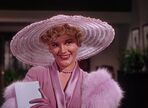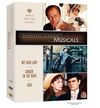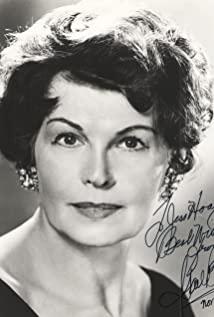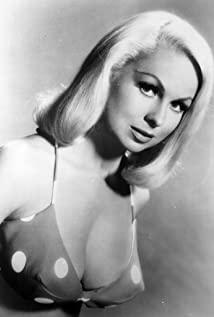"Singing in the Rain" is a Ukiyo-e in old Hollywood
A long, long time ago, there was a small village called Hollywood. Hollywood was located west of Los Angeles. It used to be nothing more than a large piece of wasteland and abundant sunshine.
One person, and the abundant sunshine in California, brought together a group of people who have dreams, want to make money, and don't want to waste money. That place is Hollywood.
Thomas Edison, invention madman, profiteer, some say he assassinated Louis Prince, an early camera competitor (whose work, about 2 seconds of 1888's "Roundhay Gardens Scene" was picked up by professional film site IMDb Admitted as the first film), the dude disappeared on a train to Paris in 1890. Not only that, but he also pirated Mériere's "Journey to the Moon" - in 1902, Edison's technicians secretly produced a large number of copies of Mériere's "Journey to the Moon", and mass-produced copies before the film was officially released in the United States. In the United States, Merieux lost the American market. In this way, Edison not only invented the light bulb, but also invented pirated movies.
It was this person who used his camera patent to suppress American production companies, causing resistance in American theaters, specializing in showing unlicensed films, and spawning a large number of independent filmmakers, all of whom gathered in sunny California. Hollywood place. At that time, filming mainly relied on natural light, so it was necessary to have enough sunlight.
Thanks to the development of the U.S. economy, American movies have also taken off, and several giants have appeared. In the early days, Hollywood was not the Big Five or the Big Six, but was called the Big Five and the Three Smalls.
The five major ones are Paramount, MGM (MGM is actually a merger of three companies, and the names of Mitro, Meyer, and Goldwyn merged to become MGM), Warner Bros., RKO, Twentieth Century Fox (RKO is a company formed by the Rockefeller consortium, its main star was Freddie Astaire, the king of tap dance, Hitchcock and its cooperation are also many, early Disney's The film is also distributed by it. The company's representative works include Citizen Kane, Beauty Plan, Snow White, and most of its film library is currently in the hands of Warner Bros.)
The three small are Universal (Universal was originally formed by seven or eight independent filmmakers to fight against big companies, who would have thought that they would become the ones who wanted to resist), Columbia, and United Arts (United Arts mainly had a few big companies at that time. It was set up by coffee actors, without contracting the main creator, without a studio, mainly relying on the company owner's own films, quite like the current personal studio, the founders include Chaplin, Griffith, Mary Pickford, Fairbank, United Art's main representative works are Chaplin's films such as Gold Rush, The Great Dictator, Stage Spring and Autumn, and the 007 series)
To understand the development of the early Hollywood film industry, it is impossible to bypass a movie "Sing in the Rain" and "A Star Is Born", the former is more comedy and sunshine than the latter, more Hollywood, more American dream , while the core theme of the latter is more realistic: that while I gain fame, I also lose my most precious lover.
"A Star Is Born" mainly describes the cost and choice of the star's predecessors and predecessors, while "Singing in the Rain", for us, is more able to show the changes of silent films and sound films. The world is hot and cold, and it is presented in the form of a relaxed comedy song and dance
How powerful is Song in the Rain?
IMDb 8.3 points 102 bits
Mtc 99 points 9th
In "Entertainment Weekly"'s "Top 100 Movie History" list, the film ranked 10th and is the highest-ranked musical.
Everyone should have an impression of the general story. The big star met a female singer by chance, the jealous female star pushed the female singer away, the big star and the female singer met again, the female singer became the voice of the female star, and finally the truth came out and the female singer was named, Lovers get married.
As a musical film, there are a lot of song and dance clips in it, but let me tell you, the only real original song in it is "Moses Thought", and the rest are old things from MGM's own huge music library.
If I were to comment on the top three songs and dances in the whole movie, I would choose NO1 "Make Them Laugh" NO2 "Moses Thought" NO3 "Singing in the Rain".
"Make Them Laugh" shows O'Connor's powerful body control and coordination.
"Moses Thought" is a classic tap dance, and the seamless and tacit cooperation between O'Connor and Jim Kelly is simply amazing!
Then comes the romance. Jim Kelly finished dancing with a fever, letting us know what sweet love is, "Singing in the Rain".
The first act of the film appeared in the Chinese Theater, where many Oscars were held (it was held at the Kodak Theater after 2002, and it is now called the Dolby Theater, which also represents the transition from film to digital) , it has witnessed the rise and fall of the classic Hollywood era (the introduction of the Paramount Act of 1948 marked the end of the era of the big studios, that is, the era of classic Hollywood)
At first, movies were played in theaters. Later, a professional broadcasting venue appeared - Nickel Cinema (the four Warner Brothers made their fortune from this). What is Nickel Cinema? long like this-
At that time, the tickets for admission were a nickel, which was equivalent to 5 cents, which was very cheap. It was basically a kind of poor music at that time, but it is worth mentioning that its main audience were so-called new immigrants, Irish, Eastern European, Jewish immigrants. . We will find that there are many big stars, especially big directors, all of European descent, such as Spielberg, Coppola, Martin Scorsese, Polanski, Woody Allen, Mel Gibson
The first nickel theaters appeared in 1905, and about a decade later they were gradually replaced by the more familiar luxury theaters.
Then the first multiplex theater appeared in a shopping mall in Kansas City, USA in 1963. Its owner divided the screening hall in two so that he could make way for the ticket window and the ordering area in the middle to serve at the same time. Two groups of audiences watching different films, basically after entering the 1970s, the mainstream of the cinema has become the model of multiplex + shopping mall
Basically, we can sort out the evolution of a theater now, theaters - nickel theaters - sound equipment theaters - luxury theaters in the center of the city - community theaters as the middle class fled the city - now multiplex theaters.
Almost every revolution has a successful business example, such as Warner Bros. when it went from silent to sound; another example is the 1920s, when social class and consumption habits underwent major changes (mainly the rise of the middle class and the flight from cities) The success of the Chicago Balaban-Katz Cinema Company (it owns 20% of Chicago's theaters, but accounts for 5% of the U.S. box office), it boldly experimented with a luxurious and thoughtful movie palace and closer proximity to the community. The way the theaters go hand in hand, plus the first introduction of an air-cooling system (in fact, this cooling system was originally designed for Chicago's slaughterhouses), better pre-screening wait Ziki Productions merged to become Paramount.
The second girl on the right is also the villain. The position in the film is that of a blond fool. Actually, I think some of this image is in Black Mary Pickford. She and the male protagonist are the golden boy and girl on the screen, people's ideal lover, but in fact Privately, each other's teeth tickled.
The scandals between the two people are flying all over the sky, but they are all hype. At that time, there were about 20 kinds of star magazines in the United States, and the sales volume was between 200,000 and 1 million, and the sales of several weekly magazines could already cover a quarter of the weekly audience. And in these magazines, without exception, the most popular column is the so-called gossip.
After the grand premiere, the central backdrop in the film, and the focus of our article, emerged, showing an experimental piece of sound film.
The emergence of sound movies was an important turning point in the Hollywood film industry, and it also brought a giant to Hollywood - Warner Bros.
Now I want to mention the man who is hated and admired again, Edison. He announced the invention of the super sound film system in 1913. Unfortunately, after a fire, it was all burnt out, but it was a good start. Later, many companies in the United States began to study sound movies.
Among them, AT&T's system was the most sensitive and had the best effect, so it tried to make a few short films by itself, eager to break into the film circle.
At this time, Warner Brothers took the lead, stood up and shouted: I am my own, local tyrant, I will show you the way! Be the pioneer of giants in the film industry.
So Warner Bros. mastered the most advanced sound film technology at the time.
Speaking of it, the fate of the two is really not shallow. Nearly a hundred years later, in 2016, the American Telephone and Telegraph Company acquired Time Warner. Juicy big peach.
Now that the technology is in place, Warners now has the idea to challenge MGM and Paramount, when they still lack one thing - money
They finally found the right person on Wall Street, Goldman Sachs Bank, who provided Warner Bros. with a credit line of $4 million and assisted it in issuing $3 million in public debt, totaling $7 million, which is equivalent to 1 billions of dollars.
With the money, Warner Bros. refurbished the studio's equipment, built a small theater chain, established a global distribution company, several broadcast stations, a film lab, and most importantly, worked with Western Electric, The sound film equipment company established by the American Telephone and Telegraph Company, Wei Taifeng, is not only the name of the company, but also the name of the process of adding sound to film.
Let's look at the Vitaphone sound camera above. It was shot in a separate soundproof cabin, so that the microphone would not be affected by the rotation of the machine. (We can see this detail in "Singing in the Rain", that paragraph is particularly funny)
However, in fact, from the early 1900s to the 1920s, a large number of companies including Edison were studying sound movies, but unfortunately they failed in commercialization. Therefore, large companies such as Paramount MGM have always been for sound movies. Be skeptical.
So when Warner Bros. suffered a huge loss of $1 million in 1925, Goldman Sachs and Warner Bros. did not waver in their attitudes toward sound movies, and we can learn that success requires a firm heart.
In the early stage, Wei Taifeng mainly made a series of short films with sound, which were bundled with silent commercial films. These short films with sound were all juggling films, and the content was all acrobatics. On the other hand, they launched stage plays and operas with sound. The first experimental opera with sound was "Don Juan" in the picture below.
When the content was in, Warner really launched a massive sales war, pitching theaters across the country to persuade them to install audio equipment, and by April 1927, 100 theaters across the U.S. could show Vitae short films.
Off topic, AT&T disliked the slow progress of Warner Bros. at this time, tore up the cooperation agreement, lost money, and went to 20th Century Fox, but fortunately, they gave Wei Taifeng the power to continue to use their technology. Let me say that later, they came together with Paramount and MGM through their Western Electric Company.
At the same time, 20th Century Fox also released a sound film system called Moweitong, and they took a completely different path-news documentaries. Warner here.
The output of Weitaifeng audio clips is getting higher and higher, and it has reached a speed of five per week.
Everything is ready and only owed to the east wind. After three years of opening and testing, the box office success of Warner Bros. in the spring of 1928 came almost "overnight". "The King of Jazz" became the biggest box office hit of 1927-1928.
At the time, a silent film was active in theaters for a week at most, and the film could run for weeks, or even months, with unabated audiences (in the last century, in the absence of a publicity process like today's) In the beginning, it was only through the word-of-mouth model that a film could be a big hit).
At this time, as an emerging form of screening, sound movies are likely to encounter one of the most deadly threats, which is failure. Fortunately, due to the production and screening of a large number of sound vaudeville films before, Warner Bros. already has a group of trained professionals at this time. Veteran people, as well as a wealth of experience, can constantly respond to ad hoc needs.
Over the course of a year, Warner's sound films made millions of dollars in profits. By 1930, Warner Bros. had reached the pinnacle of the American film industry in terms of size and profits.
If I have a chance, next time I will talk about crows and sparrows, and the development of Chinese films.
View more about Singin' in the Rain reviews











